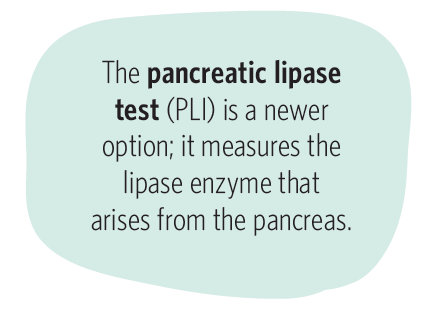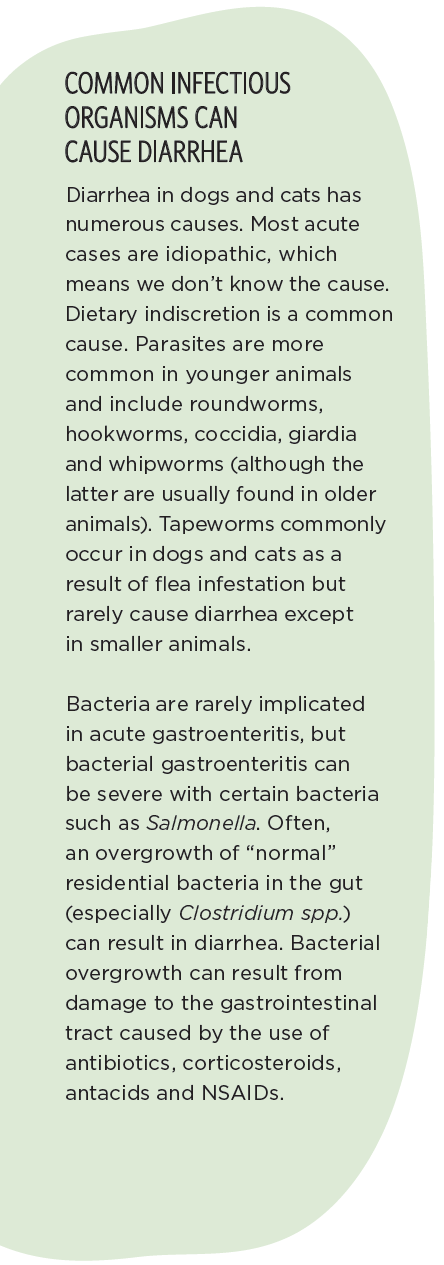Diagnosing your animal’s digestive problems

Digestive problems are common in dogs and cats, and can be challenging to diagnose. These tests narrow down the causes and make effective treatment possible.
Digestive problems are among the most commonly-seen problems in dogs and cats. Symptoms such as diarrhea, vomiting and weight loss have many causes, and getting to the root of the issue can be difficult without the right diagnostics. The tests outlined in this article can help determine what’s up with your animal’s digestive system, thereby ensuring the correct treatment and a successful recovery.
Commonly-used tests for GI disease
1. Microscopic fecal examination-fecal float/smear
The simplest, least expensive, and most commonly-performed test is a microscopic examination of your animal’s feces (stool). This test looks for the eggs of some, but not all, common parasites. Dogs and cats that test positive on this test are typically treated with some sort of deworming. I believe you should always bring a fresh fecal sample (less than 48 hours old) to every veterinary visit as this test reveals so much about your animal’s health.
 2. Fecal culture and PCR testing
2. Fecal culture and PCR testing
A fecal culture is not commonly needed, but it’s important in cases of chronicity and when other tests may not show a positive answer. It involves placing small amounts of feces on special culture plates. Any bacterial growth is then tested to determine which bacteria are present. Because feces normally contain large numbers of many bacterial species, I tend to only run a culture if I’m worried about a rare infection of pathogenic bacterial species. A sensitivity test of the pathogenic bacteria can be run to determine if antibiotic therapy might be needed. The main bacteria I screen for in a culture, gram stain, or PCR test are Clostridium perfringens, C. difficile, Campylobacter spp., Shigella spp. and Salmonella spp.
3. Giardia antigen
Giardia is a common cause of diarrhea (and may even be present in normal animals without diarrhea). This protozoal infection is easily transmitted between companion animals and their human families. The test can be performed in most veterinary hospitals using small samples of the dog or cat’s feces. A positive test usually requires treatment with antiprotozoal medication.*
4. Fecal gram stain
While some doctors see little value in staining a fecal sample for microscopic examination, I find this test extremely helpful in determining if certain bacteria (especially Clostridium spp.) are present. The test is easy to perform and inexpensive.
5. CBC, UA, blood profile
An important part of the diagnostic plan for animals with any illness, including digestive problems, is blood testing. While the blood tests are usually normal, abnormalities may arise that can indicate coexisting illnesses. They can also give the doctor a clue about the severity of an animal’s gastrointestinal illness. Problems that can occur as a result of GI disease include alterations in blood protein levels, of either albumin or globulin, or both. When albumin levels are low in an animal with GI disease, it usually indicates a severe problem that must be addressed. Changes in blood protein levels are rarely associated with too much or too little protein in the diet. A urinalysis may also indicate underlying problems associated with the GI problem or general health of the dog or cat, especially in those that have increased levels of urine protein or bilirubin.
 6. Pancreatic tests
6. Pancreatic tests
Because GI disease may be caused by pancreatitis (pancreatic inflammation), specific tests that look at pancreatic function may be helpful. Amylase and lipase testing are inexpensive to run and included on many standard blood profiles. However, they are not perfect and can give false positive and false negative results, so they must be interpreted carefully.
The pancreatic lipase test (PLI) is a newer option. It measures the lipase enzyme that arises from the pancreas and is not as easily influenced by other factors. It can be used to test for both pancreatic enzyme insufficiency as well as pancreatitis; in fact, it is used by many doctors as the test of choice for pancreatitis. It is helpful to run this test in any dog or cat with vomiting or diarrhea, or even those with vague signs that may indicate GI disease, such as lethargy and lack of appetite.
7. TLI/cobalamin/folate
These specific GI tests are great for checking for the B-vitamin deficiency that can occur from GI disease. They can also indicate bacterial overgrowth (often coinciding with severe acute or chronic GI disease).
TLI (trypsin-like immunoreactivity), tests for proper functioning of the exocrine pancreas (the part of the pancreas that makes and secretes the various enzymes necessary for proper digestion and nutrient absorption). Low values indicate a disease called exocrine pancreatic insufficiency (EPI). Animals with EPI typically lose weight and have chronic diarrhea; German shepherd dogs are more commonly afflicted with this condition than other breeds. Increased values often indicate pancreatitis or malnourishment; kidney failure may result in slightly increased values.
Cobalamin (vitamin B12) and folate (vitamin B9) testing reveal information about small intestinal function.
Serum folate concentration can be decreased in proximal small intestinal disorders as it requires a healthy GI tract for absorption, while serum cobalamin concentration can be decreased in distal small intestinal disorders and EPI. In dogs and cats with diffuse small intestinal disorders, both serum folate and cobalamin concentrations can be decreased. Finally, a decreased serum cobalamin concentration and an increased serum folate concentration can be seen in dogs with small intestinal bacterial overgrowth (SIBO). An overgrowth of bacteria make folic acid, causing increased levels of folate, while intestinal disease and EPI result in decreased cobalamin absorption. Cobalamin deficiency in humans has been shown to cause systemic disease, and this may also be true in our animals.
Since cats and dogs with cobalamin deficiency often do not respond to treatment of the underlying gastrointestinal disorder unless cobalamin is supplemented, this testing is important in animals with severe or chronic GI disease.
8. Radiography/ultrasonography
Radiography and ultrasonography don’t usually give a diagnosis per se, but are helpful in giving an overall impression of the animal’s health. Occasionally, inflammatory bowel disease (IBD) can be suspected based on an abdominal ultrasound, and certainly obstruction with foreign objects may be identified on radiographs or ultrasound examinations. I occasionally find other more serious problems with radiography and ultrasonography, including bladder stones and tumors of the liver and spleen. These “accidental” findings are often lifesaving, especially when tumors are involved, since early treatment can often cure the animal of a disease that would normally not be diagnosed until it’s more advanced.
9. Endoscopic biopsy
CT and MRI scans are rarely needed to diagnose the cause of GI diseases, but endoscopic biopsies are often done to allow proper diagnosis.
Endoscopic biopsy requires your dog or cat to be anesthetised, similar to when you have a colonoscopy. The doctor will examine the upper or lower GI tract, depending on where he feels the disease may be present. After visually examining the GI tract with the endoscope, small pinch biopsies are taken and examined by a pathologist under the microscope. This test is really the only good way to diagnose IBD, and to determine what organisms or cell types are causing the disease, allowing treatment to be fine-tuned for the animal.
While endoscopic biopsy allows us to diagnose many diseases previously only diagnosed with surgical biopsy, there are rare instances when the disease lies deeper in the tissues of the GI tract. Because endoscopic biopsy only checks the superficial layers, disease is sometimes missed with this test. In these cases, a surgical biopsy might be needed.
If your dog or cat is having digestive problems, especially if they’re chronic, the tests outlined this article can help uncover the cause and get him on the road to recovery as soon as possible.
_____________________________________
*While I’ve indicated various conventional drug treatments for some of the digestive problems these tests reveal, holistic doctors will also include natural therapies to help heal a damaged GI tract, including various herbs and homeopathics, enzymes, fatty acids and probiotics, plus detoxification with fluids, vitamins, herbs and homeopathics.



